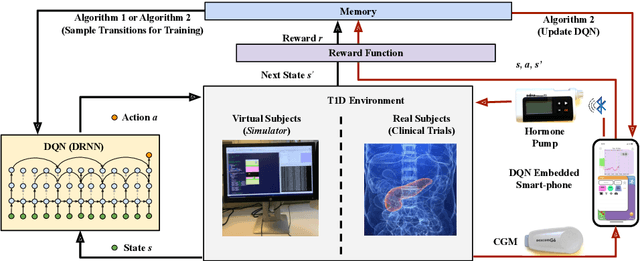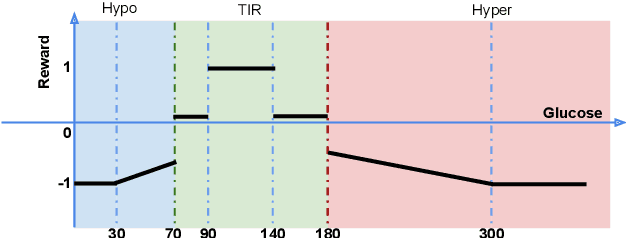Pau Herrero
Basal Glucose Control in Type 1 Diabetes using Deep Reinforcement Learning: An In Silico Validation
May 18, 2020



Abstract:People with Type 1 diabetes (T1D) require regular exogenous infusion of insulin to maintain their blood glucose concentration in a therapeutically adequate target range. Although the artificial pancreas and continuous glucose monitoring have been proven to be effective in achieving closed-loop control, significant challenges still remain due to the high complexity of glucose dynamics and limitations in the technology. In this work, we propose a novel deep reinforcement learning model for single-hormone (insulin) and dual-hormone (insulin and glucagon) delivery. In particular, the delivery strategies are developed by double Q-learning with dilated recurrent neural networks. For designing and testing purposes, the FDA-accepted UVA/Padova Type 1 simulator was employed. First, we performed long-term generalized training to obtain a population model. Then, this model was personalized with a small data-set of subject-specific data. In silico results show that the single and dual-hormone delivery strategies achieve good glucose control when compared to a standard basal-bolus therapy with low-glucose insulin suspension. Specifically, in the adult cohort (n=10), percentage time in target range [70, 180] mg/dL improved from 77.6% to 80.9% with single-hormone control, and to $85.6\%$ with dual-hormone control. In the adolescent cohort (n=10), percentage time in target range improved from 55.5% to 65.9% with single-hormone control, and to 78.8% with dual-hormone control. In all scenarios, a significant decrease in hypoglycemia was observed. These results show that the use of deep reinforcement learning is a viable approach for closed-loop glucose control in T1D.
Convolutional Recurrent Neural Networks for Glucose Prediction
Aug 16, 2018



Abstract:Control of blood glucose is essential for diabetes management. Current digital therapeutic approaches for subjects with Type 1 diabetes mellitus (T1DM) such as the artificial pancreas and insulin bolus calculators leverage machine learning techniques for predicting subcutaneous glucose for improved control. Deep learning has recently been applied in healthcare and medical research to achieve state-of-the-art results in a range of tasks including disease diagnosis, and patient state prediction among others. In this work, we present a deep learning model that is capable of predicting glucose levels over a 30-minute horizon with leading accuracy for simulated patient cases (RMSE = 9.38$\pm$0.71 [mg/dL] and MARD = 5.50$\pm$0.62\%) and real patient cases (RMSE = 21.13$\pm$1.23 [mg/dL] and MARD = 10.08$\pm$0.83\%). In addition, the model also provides competitive performance in forecasting adverse glycaemic events with minimal time lag both in a simulated patient dataset (MCC$_{hyper}$ = 0.83$\pm$0.05 and MCC$_{hypo}$ = 0.80$\pm$0.10) and in a real patient dataset (MCC$_{hyper}$ = 0.79$\pm$0.04 and MCC$_{hypo}$ = 0.38$\pm$0.10). This approach is evaluated on a dataset of 10 simulated cases generated from the UVa/Padova simulator and a clinical dataset of 5 real cases each containing glucose readings, insulin bolus, and meal (carbohydrate) data. Performance of the recurrent convolutional neural network is benchmarked against four algorithms. The prediction algorithm is implemented on an Android mobile phone, with an execution time of $6$ms on a phone compared to an execution time of $780$ms on a laptop in Python.
 Add to Chrome
Add to Chrome Add to Firefox
Add to Firefox Add to Edge
Add to Edge